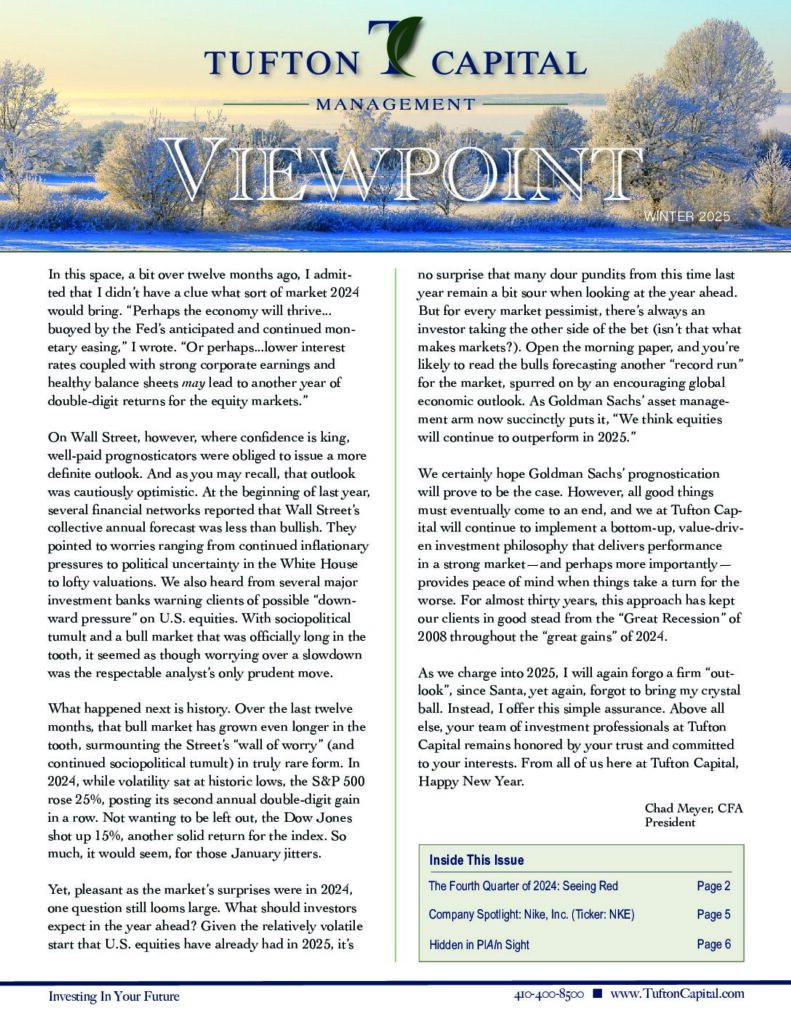 It’s difficult to read the financial news these days without noticing some storm clouds on the horizon. European debt woes, budget shortfalls everywhere, a lackluster economic outlook and falling home values represent a few of the problems the world will grapple with for the foreseeable future. Such uncertainty poses risk for all investments and contributes to the volatility in the market value of securities. On occasion, the volatility can feed on itself and lead to outright fear. Time and again, history has proven that at any single point in time markets are often far from rational and subject to the very real human emotions of fear and greed. We’ve seen exuberance and greed abound in market “bubbles” such as the internet and technology craze and numerous housing booms. Such excess has always been followed by “busts,” which is nature’s way of restoring balance. The good news is that eventually markets do find equilibrium and over the long haul sanity prevails. The absolute truth of the matter is that no one (more…)
It’s difficult to read the financial news these days without noticing some storm clouds on the horizon. European debt woes, budget shortfalls everywhere, a lackluster economic outlook and falling home values represent a few of the problems the world will grapple with for the foreseeable future. Such uncertainty poses risk for all investments and contributes to the volatility in the market value of securities. On occasion, the volatility can feed on itself and lead to outright fear. Time and again, history has proven that at any single point in time markets are often far from rational and subject to the very real human emotions of fear and greed. We’ve seen exuberance and greed abound in market “bubbles” such as the internet and technology craze and numerous housing booms. Such excess has always been followed by “busts,” which is nature’s way of restoring balance. The good news is that eventually markets do find equilibrium and over the long haul sanity prevails. The absolute truth of the matter is that no one (more…)
 The first quarter of 2011 was dominated by a series of events that eclipsed the financial markets as front-page news. An unexpected breakdown in the political order in North Africa spread throughout the Mideast, and several governments important to Western economic interests tottered on the brink of collapse by quarter’s end. Governments in Tunisia and Egypt fell and significant unrest spread to Bahrain, a small but important financial center responsible for the coordination of Middle Eastern oil settlements. We were surprised that by quarter’s end a Western coalition had begun offensive air operations against the repressive government of Libya and, under the supervision of NATO, the West was attempting to bring down the government of Muammar Gaddafi, the long-running leader of Libya.
The first quarter of 2011 was dominated by a series of events that eclipsed the financial markets as front-page news. An unexpected breakdown in the political order in North Africa spread throughout the Mideast, and several governments important to Western economic interests tottered on the brink of collapse by quarter’s end. Governments in Tunisia and Egypt fell and significant unrest spread to Bahrain, a small but important financial center responsible for the coordination of Middle Eastern oil settlements. We were surprised that by quarter’s end a Western coalition had begun offensive air operations against the repressive government of Libya and, under the supervision of NATO, the West was attempting to bring down the government of Muammar Gaddafi, the long-running leader of Libya.
The European banking system came under pressure as banks in Portugal, Greece, Italy, and Spain joined those of Iceland and Ireland in experiencing varying degrees of loss of confidence by depositors and members of the European Union. France and Germany, the wealthy nations in the E.U., although willing to aid the affected nations, offered bailout terms that were quite steep. At quarter’s end, the E.U. banking situation remained unresolved. (more…)
 This summer marks my thirtieth anniversary in the financial service industry, beginning at the old Maryland National Bank and ultimately as a senior executive at Ferris, Baker Watts. These two proud institutions, along with countless others, became victims to the ever changing landscape of the industry. Today, “Wall Street” and, in fact, the world’s financial system are dominated by comparatively few investment factories that offer every conceivable alternative investment and access to capital that was unthinkable thirty years ago. Such “progress” has paralleled the dynamic growth of the whole economy and contributed to the advances in our standard of living. Although it would be difficult to argue that we haven’t progressed, does that mean that we have greater clarity about the future? Has innovation and sophistication led to superior investment performance? Are the financial decisions we face any simpler or easier? The answer to these questions is a resounding no.
This summer marks my thirtieth anniversary in the financial service industry, beginning at the old Maryland National Bank and ultimately as a senior executive at Ferris, Baker Watts. These two proud institutions, along with countless others, became victims to the ever changing landscape of the industry. Today, “Wall Street” and, in fact, the world’s financial system are dominated by comparatively few investment factories that offer every conceivable alternative investment and access to capital that was unthinkable thirty years ago. Such “progress” has paralleled the dynamic growth of the whole economy and contributed to the advances in our standard of living. Although it would be difficult to argue that we haven’t progressed, does that mean that we have greater clarity about the future? Has innovation and sophistication led to superior investment performance? Are the financial decisions we face any simpler or easier? The answer to these questions is a resounding no.
Placing client interests first is the critical challenge in our industry. (more…)
Hello again everyone. Sorry that this blog has taken an unannounced hiatus. We are back.
The markets had a solid week, with the Dow, S&P and Nasdaq all ending solidly higher: 1.28%, .98% and 1.19% respectively. Capping off the week was the March jobs report. We saw 216,000 jobs created last month, compared to the expected 180,000. The unemployment number came down as well, to 8.8%. That figure has declined a full percent over the last four months. It would seem that employment is gaining some real traction. We expect this trend to continue.
A trend that we are not so cheerful about is inflation. We’ve seen manufacturers across industries saying that they need to increase prices to match rising input costs. The Fed’s infusion of umpteen billions of dollars through their various programs puts more upward pressure on prices. A lot of attention from the media is focused here now, and we think it is something that needs to be watched closely.
Next week, we’ll be looking towards the consumer when consumer confidence numbers are announced Friday. The other, always-important piece of the consumer’s confidence, continuing jobless claim numbers, will bear consideration as well.
This week’s factoid: The radiation exposure associated with living within 50 miles of a nuclear power plant for one year is .09 μSv, which is slightly less than the radiation exposure associated with eating one banana (.1 μSv).

 We’ve all heard about the importance of asset allocation. But how can it really help you? What do those different allocations mean for risk? And do you really need to reallocate?
We’ve all heard about the importance of asset allocation. But how can it really help you? What do those different allocations mean for risk? And do you really need to reallocate?
This study demonstrates how splitting one’s assets between bonds and stocks in different ways affects the performance of a portfolio, while simultaneously showing the effect that rebalancing the portfolio has on returns and risk (volatility). The analysis constructs a $1,000,000 investment starting in 1983. Various portfolio strategies are then modeled, and the results shown as of December 31, 2009. As one might expect, the highest returns are achieved by allocating a higher percentage of funds into stocks, but the risks associated with such an allocation are much higher. (more…)
 The economy and the financial markets performed well in the fourth quarter and for the full year 2010. The Standard and Poor’s 500 index increased 10.49% in the quarter and 14.79% for the full year, somewhat above the long-run average return for common stocks since records were established in 1926. Bonds also delivered positive returns, and the 10-year and 30-year treasuries provided returns of 7.9% and 8.7%, respectively.
The economy and the financial markets performed well in the fourth quarter and for the full year 2010. The Standard and Poor’s 500 index increased 10.49% in the quarter and 14.79% for the full year, somewhat above the long-run average return for common stocks since records were established in 1926. Bonds also delivered positive returns, and the 10-year and 30-year treasuries provided returns of 7.9% and 8.7%, respectively.
But in the fourth quarter of 2010, there was a significant divergence in the performance of stocks vs. bonds. The sharp fourth-quarter advance in stocks (10.49%) was not matched by treasury returns. In the final quarter of 2010, the ten-year treasury fell 5.6% and the thirty-year treasury declined 9.8%. The bond market appears to be reacting to a sharp rise in the projected fiscal 2011 federal deficit of $1.27 trillion ($1,270 billion), up from $480 billion in fiscal 2009. Calls for spending cuts, repeal of the health care program, and a contentious debate over increasing the government debt ceiling may have temporarily spooked the bond market. (more…)
 Pssst… if ever you have the chance to hear Stuart Varney speak, grab it! Emblematic of the “coat hangers” in our respective mouths, wife Kirby and I were presented that opportunity back in November by way of The Fund for American Studies’ 2010 Leadership Network.
Pssst… if ever you have the chance to hear Stuart Varney speak, grab it! Emblematic of the “coat hangers” in our respective mouths, wife Kirby and I were presented that opportunity back in November by way of The Fund for American Studies’ 2010 Leadership Network.
For those unfamiliar with the gentleman, he may be found daily serving as the anchor of Fox Business News’ morning show, Varney & Company… for those of you groaning at the mere mention of the word Fox, relax, Stuart has logged time with both CNN and CNBC. In fact, with Larry King’s recent retirement, Varney may be the dean of cable news hosts, having joined CNN’s Manhattan bureau at its genesis back in 1980. A graduate of the London School of Economics, his coverage of the 1987 stock market crash earned him the coveted Peabody Award for excellence in journalism. (more…)
Does anyone remember this? In May of last year, this gentleman argued on the air that the Dow would reach 5000 by the end of the year- and that wasn’t even his worst scenario! He appeared alongside Jim Hardesty, who rightly argued against his wild “predictions”.
[flashvideo file=http://tuftoncapital.com/media_data/media_v/100517.flv /]The Dow ended the year at 11,577.
Markets edged up a bit this week. The Dow led the charge, up .72%, with the S&P and Nasdaq lagging a bit, up .28% and .21%, respectively. Promising reports on layoffs, factory production and consumer spending have contributed to hopes that 2011 will pick up nicely.
Initial jobless claims unexpectedly fell on Thursday. The number of claims declined 3,000 to 420,000, compared to estimates of a rise of 4,000. This is good news, but continuing claims increased by 22,000 to 4,135,000. The mixed data points to a slow recovery- as we already know. But we do continue to believe that we will steadily, if slowly, win this race.
Next week will be a quiet one, given Christmas coming up Saturday. Durable goods and new home sales numbers might receive some focus.
This week’s factoid: The $7.2 billion recovered from the estate of the biggest beneficiary to Bernie Madoff’s fraud represents about 36% of the estimated total investment losses.
The markets had an up week- to varying degrees. Tech was way out ahead, with the Nasdaq up 1.78% for the week. The S&P chugged along heartily, gaining 1.28%. The Dow dragged its feet a bit, ending the week up .25%. The economy continues to show signs of improvement, and Europe seems to be slowly getting its financial house in order.
This week, yields on two-years and longer duration bonds jumped some 25 basis points- devastating on low-yielding bonds bonds’ prices. It’s possible we’re finally seeing the turn in bonds for which we have been calling for some time now.
Next week, we’ll be looking at consumer sentiment, inflation, and housing numbers. And, as always, weekly claims.
This Week’s Factoid: The U.S. is the only country in the Organization for Economic Development and Co-operation to tax money when it is repatriated to this country. Cisco’s CEO, John Chambers, says that there is $1 trillion held by American companies in foreign countries, waiting to be repatriated to the U.S. The companies are hesitant to do that, however, given the 35% tax.
The markets had a good week. The Dow ended up 2.62%, the S&P up 2.97%, and the Nasdaq up 2.24%. Fueling the growth was the November ADP National Employment Report, which reported private nonfarm payrolls to be up by 93,000 jobs. Also helping was movement towards stability and resolution in the continuing debt problems in Europe, as well as the U.S. government working toward extension of tax cuts. Despite a disappointing employment report from the government Friday, the markets finished the week strong.
There has been a dramatic increase in interest rates recently. Money is finally coming out of bond funds. Money is not moving into stock funds yet, but that money must eventually go somewhere. These moves could signal renewed confidence in the markets and in the economy.
Next week is light in economic data, and no earning reports from companies stand out.
This week’s factoid: Spain has failed to attract the 2018 World Cup to its shores, and the event will instead be hosted by Russia. We have our fingers crossed that Spain will be more successful in other endeavors in the coming weeks.
The markets had a disappointing week after a string of mostly uninterrupted positive ones. The Dow was down 2.12% for the week, the S&P down 1.79%, and the Nasdaq lost 2.29%. Spearheading the decline is the decision by the Chinese government to raise interest rates in response to fears of rising inflation. Also, we had a couple of high-profile companies, Cisco and Disney, with challenging earnings calls.
We see that Wall Street is now back into full gear, and financial wizards are up to their old tricks. For example, BWAY found buyers for PIK bonds- payment in kind. “Payment in kind” means that the bonds’ interest is paid by some means other than cash, usually by increasing the principal owed to the bondholder. Why someone would purchase such a bond is beyond us.
Another example is bonds being issued that are backed by assets that are already promised as security on another loan- like a second mortgage. The problem is, if the company becomes insolvent, the collateral can’t very well go to both bondholders.
Next week we have a very full week. The key components will be retail sales, housing and inflation. There are also numbers coming out on manufacturing and consumer confidence. The market will be focused on economic data next week.
Baby boomers throughout Maryland are facing a two-pronged assault on their investment portfolios. As we all know, stocks have performed very poorly over the last ten years. Equally as important and probably less obvious is that investment income has been under assault as well. Not only have yields been falling, but during the last recession many companies cut their dividends. It has become very difficult to grow portfolios in the traditional way,and just as difficult to grow investment income. The importance of a growing income stream cannot be overstated, especially as baby boomers begin to retire. Growing investment income is a problem—and that problem in itself is growing. (more…)
A quick update this week.
The markets ended the week mixed; the Dow was down .13%, but the S&P was mostly flat at +.02%, and tech had a great week with the Nasdaq up 1.12%.
We’re looking at Microsoft this coming week. We haven’t come down on either side yet, but there are some items of interest. A deal for “social search” between Bind and Facebook may reinvigorate the image of the aging tech company, making it relevant again. Also in that vein is Microsoft’s stance as a commercial vs. a consumer company. It has been some time since anyone’s been excited about a new Microsoft offering. Instead, we are excited by Google or Apple. Microsoft may be becoming an “old giant,” but we can see that the position of “lumbering old tech giant“ might not be so bad: it’s worked out pretty well for IBM.
“Quantitative Easing” sounds like some erudite process performed by financial wizards, the particulars of which we could never understand. In reality, it’s much simpler. Explaining its particulars does take a bit of doing, though.
The term “Quantitative Easing” is really rather misleading. All it is, really, is the Fed injecting new money into the economy. The Fed is often increasing the money supply, but QE involves doing so in ways other than its normal methods (more on its “normal methods” in a moment). It is no more “quantitative” than any other process involving money, and “easing” just means “increasing the money supply.” (more…)




